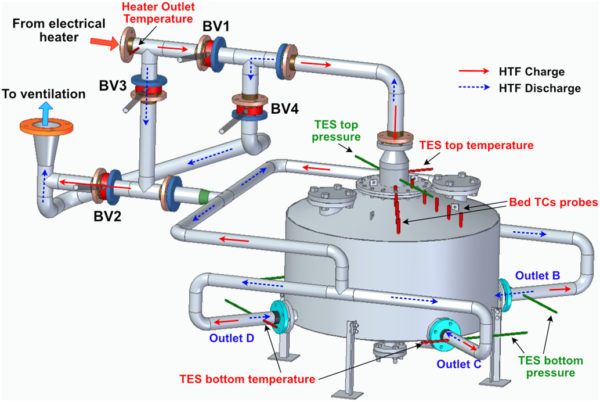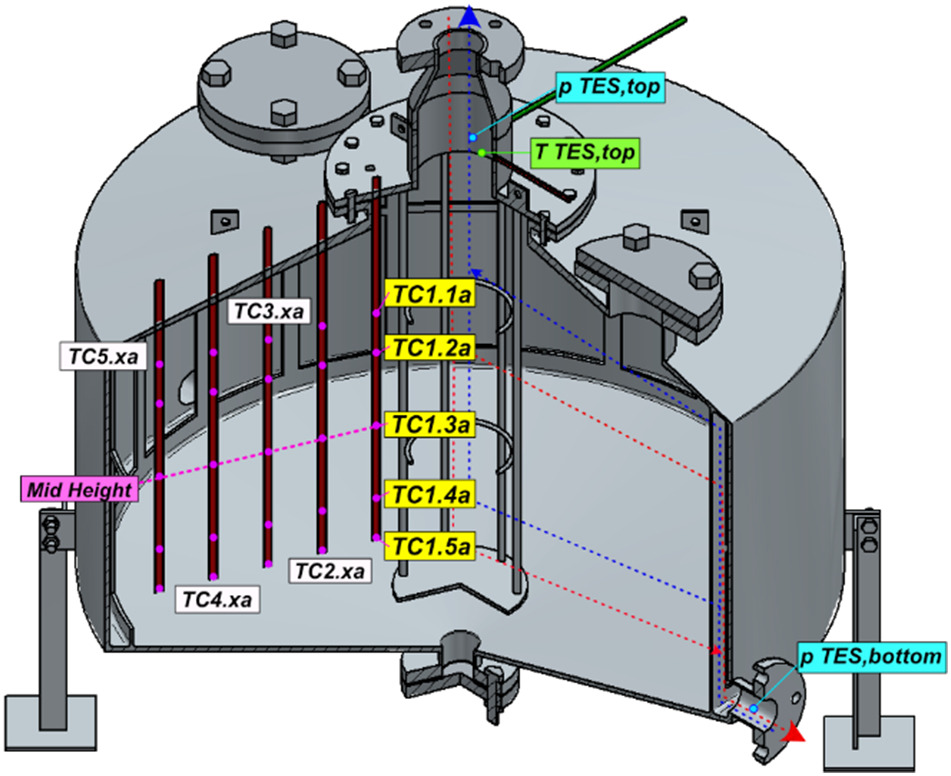Researchers from Sweden's KTH Royal Institute of Technology have designed a high-temperature packed bed thermal energy storage (TES) system that could be used for the storage of electricity generated by large-scale renewables.
The 49.7 kilowatt-hour thermal (kWhth) system is based on thermal storage in “packed beds” – where a heat storage medium is sealed in an insulated container. It includes heat transfer mechanisms within the system itself.
“Packed-bed sensible TESs store thermal energy by heating and cooling solid particles by means of a heat transfer fluid (HTF) that flows through the beds,” the scientists explained. “Previous studies have shown that packed-bed TESs can offer several advantages: cheap storing material; wide working temperature range; direct heat transfer between the HTF and the storing material; elevated chemical stability with limited degradation and corrosion.”
The system uses piping with four butterfly valves that enable consecutive thermal cycles, and an electrical heater and a mass flow controller to control charge and discharge. The heater relies on four individual heating units with a capacity of 15 KW per unit and can be operated independently depending on the air mass flow rate, target outlet temperature, and heating power.
“A pressure relief valve is installed upstream of the electric heater ensuring a maximum over-pressure in the piping system and TES of 0.3 bar, limiting the risks associated with the experimental setup,” the group specified, noting that the inlet air temperature and air mass flow rate are the main operational variables influencing the thermodynamic behavior of the system. “Since the TES often acts as a buffer, the air mass flow rate is likely to vary during the operations.”
A mass flow controller acts on a dedicated compressor, which in turn enables to define the air mass flow rate.
Popular content

Image: KTH Royal Institute of Technology, Journal of Energy Storage, Creative Commons License CC BY 4.0
The prototype was designed to operate with an air mass flow rate of 28.7 g/s, an inlet air temperature equal to 600 C during charge and 25 C during discharge, and ambient pressure. During operation, a 2-hour charge process is followed by 20 min dwell and a 2-hour discharge phase.
The thermodynamic performance of the system was assessed considering various dynamic mass flow rate profiles during the charge phase. “The air mass flow rate has been controlled during the discharge phase in order to provide constant thermal power output for extended time periods,” the group said. “Finally, short operational cycles have been performed and assessed against base case working conditions.”
The system achieved an overall thermal efficiency of approximately 70%. During consecutive short thermal cycles, the charge efficiency decreased by around 18% and the discharge efficiency raised by 35%. The test also showed that the variable air mass flow rates during the charge process negatively affect the TES performance and that air mass flow control strategies may reduce the overall performance of the system by up to 7%.
The system is described in the paper Experimental evaluation of a high-temperature radial-flow packed bed thermal energy storage under dynamic mass flow rate, published in the Journal of Energy Storage. “Future work will assess the influence of combined dynamic charge and discharge profiles, while implementing specific improvements of the TES prototype to limit the non-uniformity of the porosity distribution within the TES, minimizing its negative impact and maximizing the TES performance,” they concluded.
This content is protected by copyright and may not be reused. If you want to cooperate with us and would like to reuse some of our content, please contact: editors@pv-magazine.com.



2 comments
By submitting this form you agree to pv magazine using your data for the purposes of publishing your comment.
Your personal data will only be disclosed or otherwise transmitted to third parties for the purposes of spam filtering or if this is necessary for technical maintenance of the website. Any other transfer to third parties will not take place unless this is justified on the basis of applicable data protection regulations or if pv magazine is legally obliged to do so.
You may revoke this consent at any time with effect for the future, in which case your personal data will be deleted immediately. Otherwise, your data will be deleted if pv magazine has processed your request or the purpose of data storage is fulfilled.
Further information on data privacy can be found in our Data Protection Policy.